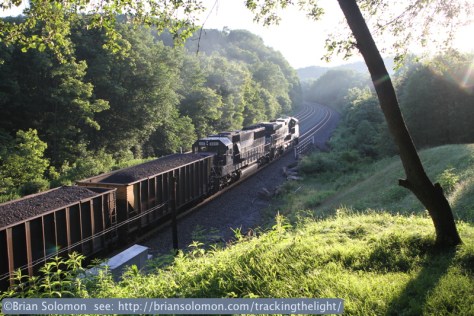Pleasant Morning on the West Slope.
In contrast from the iced grip of winter, these photographs were made on June 30, 2010. This was a gorgeous warm summer’s morning; birds twittered the tree branches as the sun light streamed through a gauzy haze to burn away the dew.
I arrived early at the famed ‘Railfan’s Overlook’ to make photographs in the early light of day. In the distance, I could hear the thunder of a heavy train climbing east toward the Allegheny Divide at Gallitzin.
Norfolk Southern’s busy former Pennsylvania Railroad mainline rarely disappoints, and this morning it was alive with trains.
Using my Canon EOS 7D, I worked the glinting sun to its best advantage as an eastward Pennsylvania Power & Light coal train clawed into view. As it worked the grade, a westward RoadRailer led by former Conrail locomotive glided down grade.
At the back of the coal train were a pair of freshly painted SD40Es making a classic EMD-roar as they worked in run-8 (maximum throttle).
How I wish I was enjoying a warm June morning on the West Slope right now!

A Norfolk Southern coal train, likely destined for Pennsylvania Power & Light’s Strawberry Ridge plant, works west at Cassandra, Pennsylvnia. Canon EOS 7D with 24mm lens, exposed at f4 1/250th second, ISO 200. Back lit morning sun highlights the grass in the foreground.



Tracking the Light posts new material every morning.
Please spread the word and share Tracking the Light with anyone who may enjoy seeing it!
http://briansolomon.com/trackingthelight/
Interested in learning more about locomotives and viewing more stunning photographs? See my book: Classic Locomotives published by Voyageur Press.





